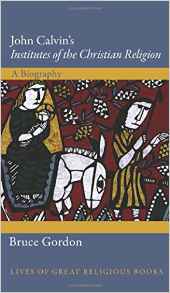 Bruce Gordon, John Calvin’s "Institutes of the Christian Religion": A Biography. Lives of Great Religious Books Series (Princeton: Princeton University Press, 2016), 277 pp.
Bruce Gordon, John Calvin’s "Institutes of the Christian Religion": A Biography. Lives of Great Religious Books Series (Princeton: Princeton University Press, 2016), 277 pp.
A guest review by Don Thorsen, Professor of Theology, Chair of the Department of Theology and Ethics, and Director, Master of Divinity, at Azusa Pacific University.
Bruce Gordon, the Titus Street Professor of Ecclesiastical History at Yale Divinity School, has written an informative and appreciative "biography" of John Calvin's theological magnum opus, Institutes of the Christian Religion. Few books have had greater impact upon Protestant Christianity. Written first in 1536, Calvin revised the Institutes more than twenty times, until its final Latin publication in 1559. Thereafter, Christians, especially in the Reformed tradition of Protestant Christianity, have been influenced by Calvin’s beliefs in the sovereignty of God, salvation by grace through faith, and the primacy of Scripture.
Gordon discusses how the Institutes emerged historically in the midst of the Protestant Reformation of the sixteenth century. He also talks about how the Institutes influenced the development of Protestantism in Europe and America. For example, the Dutch most strongly promoted Calvin’s theology, not shying away from the implications of the sovereignty of God, including the belief in double predestination. Gordon writes, “From 1539, Calvin emphatically insisted that God predestined the elect to life and the reprobate to death (double predestination), a position that separated him from his friends Philip Melanchthon and Heinrich Bullinger, who objected to the second part of the equation.” (26). Of course, from Calvin’s perspective, double predestination was “a pastoral doctrine that brought the comfort of assurance to the people and explained the problem of evil by placing the wisdom of God beyond all human understanding.” (27).
In America, the Institutes were influential in multiple ways. Calvin impacted Christian movements such as Puritanism, and leaders such as Jonathan Edwards. Gordon notes how Bryan Bademan “argued that three Calvins emerged in nineteenth-century America: the intolerant murderer of Servetus, the great hero of the Reformation, and the pioneer of religious freedom.” (113). With regard to the first view, Gordon does not shy away from longstanding criticisms of Calvin as being religiously and magisterially intolerant, epitomized by his collusion in executing Michael Servetus for heresy. In 1553, Servetus was burned at the stake for his denial of the Trinity and infant baptism, along with copies of Servetus’ books attached to his legs (223-225).
Gordon focuses more upon Calvin as the hero of the Reformation, and upon the influence of the Institutes around the world. For example, he explains the impact of Calvin upon Karl Barth, and how both men then influenced the liberation theological writings of Allan Boesak in South Africa, and Reformed Christianity in China. Boesak especially found Barth’s resistance against Nazism by the Confessing Church with its Barmen Declaration in 1934 inspirational in repelling centuries of slavery and apartheid practices in South Africa, which had been condoned by the Dutch Reformed Church (171).
In his conclusion, Gordon writes: “A book about Calvin’s book will necessarily over-emphasize the singularity of the Institutes, but there is no doubt that it remains the best-known theological work of the Protestant Reformation.” (219). I agree that, regardless of one’s theology, we cannot understand what it means to be Protestant, and how Protestantism has impacted the world, without studying, understanding, and interacting with Calvin’s Institutes.


